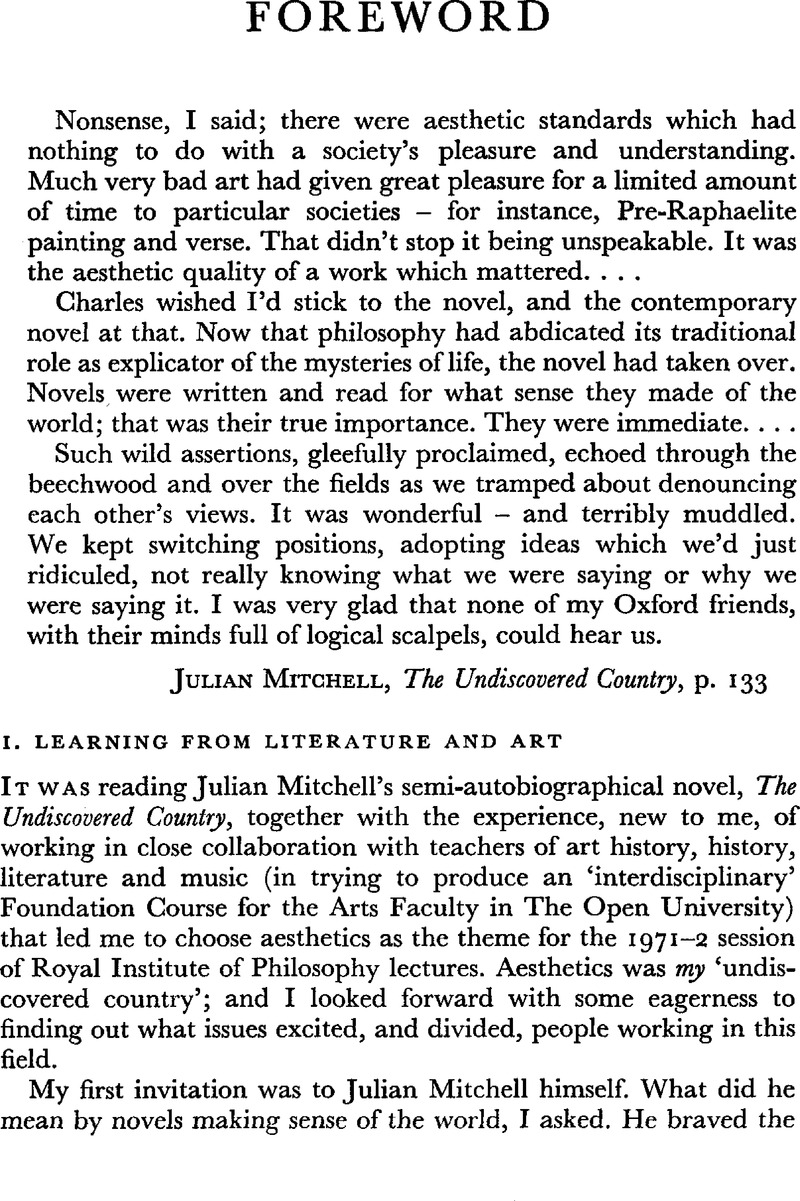Published online by Cambridge University Press: 08 January 2010

page x note 1 The reference to ‘techniques’ is puzzling. When Hare writes of reading novels as ‘an adjunct to moral thought’ (Freedom and Reason, p. 183Google Scholar) surely he is not equating what one learns from reading novels with acquiring techniques of some sort. But Beardsmore evidently thinks he is, for he takes what Gilbert Ryle says — about knowing how (to fish, shoot, make jokes, etc.) not being a matter of knowing that something is the case — to be the inspiration for Hare's view about what we may learn from reading a novel.
page xi note 1 Wollheim, Richard, Art and its Objects (Penguin Books, 1970) section 49.Google Scholar
page xi note 2 Cameron, J. M., The Night Battle (Burns and Oates, 1962) pp. 119–49.Google Scholar
page xii note 1 Blackwell, , 1968, p. 10.Google Scholar
page xiii note 1 I think that for Winch one of the main problems, if not the problem, in moral philosophy is that of the meaning of ‘moral’. See his ‘Human Nature’, in The Proper Study: Royal Institute of Philosophy Lectures, vol. 4, 1969–1970.Google Scholar
page xiii note 2 ‘The Expression Theory of Art’, in Philosophical Analysis, ed. Black, Max (Cornell University Press, 1950).Google Scholar
page xiv note 1 The notion of consummation is also implicit in his paper ‘The Critic and the Lover of Art’ in Linguistic Analysis and Phenomenology, ed. Mays, Wolfe and Brown, S. C. (Macmillan, 1972).CrossRefGoogle Scholar
page xvi note 1 ‘Gods’, Proc. Arist. Soc., 1944Google Scholar, reprinted in Wisdom, John, Philosophy and Psychoanalysis (Blackwell, 1953) pp. 152, 154.Google Scholar
page xvi note 2 The Night Battle, p. 142:Google Scholar
One of the reasons we may have for ascribing truth to a poetic representation is that it reveals to us the character of our inner feelings and dispositions; and by this I do not mean that it describes accurately inner feelings and dispositions of which we could give an account independently of the poetic representation. For reasons I have already given, it will not do to say that the truth of the poem lies in its ‘matching’ a state of affairs of which we have prior and independent knowledge.
We have the idea that the inner life may be described through introspection. We habitually talk of our feelings, passions, dispositions, capacities, in terms that suggest that introspection is to the mind and heart what sight and the other senses are to the world of nature. It is one of the great and, I believe, permanent advances recently made by philosophers in this country to have shown that this account, the monstrous offspring of Cartesian dualism and British empiricism, is impossible. The confusions in the account are legion and they provided the later Wittgenstein with many of the problems that are central to his Philosophical Investigations, a rich mine whence many lesser philosophers have carried away their portions of precious ore.
page xvii note 1 Wollheim, Richard, Art and its Objects (Penguin Books, 1970)Google Scholar section 21. See also sections 24 and 33.
page xviii note 1 Moreover Wollheim, like Pole, recognises the importance of the art-history context of works of art. In section 59 he refers to a ‘consideration, whose consequences are far-reaching indeed. And that is that in many instances the kind of order that is sought by the artist depends from historical precedents: that is, he will assemble his elements in ways that self-consciously react against, or overtly presuppose, arrangements that have already been tried out within the tradition’.
page xix note 1 Locke, John (An Essay Concerning Human Understanding (1690)Google Scholar bk II, ch. viii) distinguished between qualities which are ‘utterly inseparable from the body’, such as solidity, extension, figure, motion or rest, and number, which he called ‘primary qualities’, and ones ‘which in truth are nothing in the objects themselves but powers to produce various sensations in us by their primary qualities’, such as colours, sounds, and tastes, which he called secondary qualities.
page xix note 2 It is interesting to note that David Pole is as sure that red apples are red as Oliver Johnson is that they are not. See p. 153.
page xxi note 1 Cf. Wollheim, section 18.
page xxii note 1 Wollheim, , op. cit., section 20. See also section 55 ff.Google Scholar
page xxii note 2 Wollheim, section 40.
page xxiii note 1 On the analogical character of the language of introspection see Findlay, J. N., ‘Recommendations regarding the Language of Introspection’, in Lewis, H. D. (ed.), Clarity is not enough (Allen and Unwin, 1963).Google Scholar